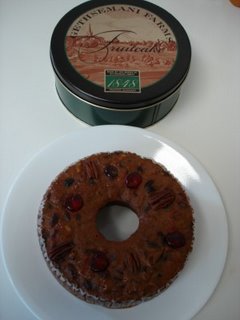I don't know who this Brother Basil is, but he makes a damn fine fruitcake.
One of my commenters suggested the fruitcake from the
Holy Spirit Monastery in Conyers, Georgia. I bought the 2-pound round fruitcake in a tin for $27.95 and shipping, for a total price of $34.89. Here it is:

Notice the little message about Brother Basil and his kitchen. The tin arrives with a cardboard cover around it:

Unfortunately, I threw that cardboard cover away, and darn if it didn't have the list of ingredients on it. Really sorry about that, but I don't have the exact ingredients. According to their website, the fruit they use in it include "peaches, pineapple, raisins, dates and cherries". The nuts? Pecans. And the liquor includes peach brandy and sherry.

From what I remember from the discarded cardboard thingy, this cake did contain a couple not-so-lovely ingredients, such as high-fructose corn syrup and perhaps some preservatives. But the flavor didn't show it too much. They do something to the top of this fruitcake, however, that I really don't like. They put some kind of glaze on the top to make it very shiny and finished looking. That's why my photo is kind of dull; I had to take it without a flash, because with flash, all you would have seen was the glare of this shiny glaze. Anyway, what the glaze does is make the top very gooey and sticky, which I found unappealing. I managed to work my way around that, though, because I really liked the flavor of this fruitcake.
The consistency of the cake is very similar to my
favorite--need I even mention which one that is anymore? There was enough cake in the mix so you could both see and taste it. The peach brandy and sherry gave it a lovely rich flavor, and even though it has raisins in it, which I tend to hate, they were offset by a really nice mixture of all your basic fruitcake food groups--cherries, pineapple, etc.
So now I have to rate it, or at least rank it, huh? Sigh. I wish I had a slice of each one of the monastery fruitcakes I've eaten in front of me right now. They are all so good, containing such good ingredients and having such good flavor, and now I'm having trouble even remembering what they tasted like.
OK, well, since it's my blog, I'm going to bump all of them down one and put this one in second place. It did taste really good.
It could also be that I haven't been getting to the grocery story much lately so I've been really hungry each time I cut into it, and so have been treating it more as a meal than a dessert. I mean, I don't want to denigrate it at all, and its number 2 position is earned: I liked the flavor of this cake. I just wonder how much hunger affects how much I enjoy a fruitcake. Perhaps a subject for another post. But really, who am I kidding? Nothing, not even hunger, could get me past the flavor of some of the nasty ones.
So there you go. Thanks, anonymous commenter--you've pointed me to a goody. Holy Spirit Monastery at number 2. Just don't get it if you don't like shiny goo on the top of your cake.
UPDATE: from customer service, here are the ingredients: Pecans, Pineapple, Cherries, Dates, Sherry Wine, Butter, Eggs, Enriched Wheat Flour, Raisins, Peach Brandy, Sugar, Honey, Invert Sugar, Corn Syrup, Almond Paste, Contains 1% or Less of Locust Bean Gum, Modified Corn Starch, Salt, Cinnamon, Nutmeg, Calcium Propionate[ A Preservative], Sulfur Dioxide, Food Coloring [Red 40, Blue 1, Yellow 5], Methylcellulose Gum.


























